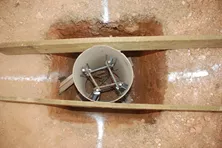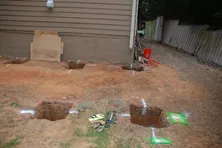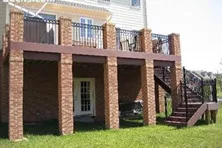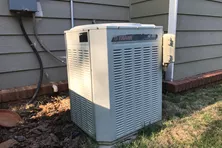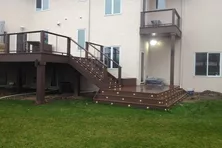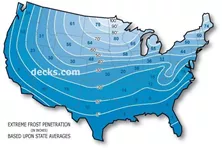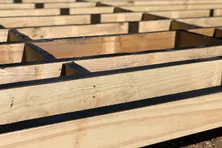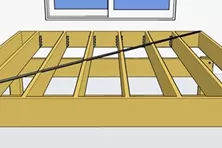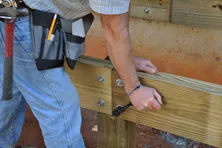How to Use Concrete Deck Blocks
Concrete deck blocks are primitive building materials that look similar to children’s toys that snap together to build things. Their purpose is to spread out the extreme concentrated loads at the bottom of wooden deck posts onto strong soil. They are just one option for support deck weight and come with certain pros and cons. Perhaps the biggest drawback to concrete deck blocks is their limited potential as you never want to bury them in the ground thus causing potential rot issues with the wooden deck posts.
What are Concrete Deck Blocks?
A deck block is in many ways just a simplified version of a “precast foundation,” a foundation type recognized by building codes. They’re subject to all of the same requirements as a typical footing, regardless of not being cast-in-place. They must have a sufficient bearing area (the area of the block that sits on the earth) and be a minimum of 12-inches below grade, or below the local frost depth. They cannot, however, be simply placed at grade level.
Deck blocks are not to be confused with real concrete piers that are either precast and weigh hundreds and hundreds of pounds or with piers you cast in place using precut rebar reinforced plastic forms that can easily be placed and handled by the average person. Precast concrete piers must be set with a crane or backhoe on the job site.
Concrete deck blocks are very crude and resemble the cap you might have on a cheap ballpoint pen. A wood deck support post fits down inside the concrete pier block. Concrete lugs on the block act like the sidewalls of a pen cap. Just as you pull on the cap to expose the pen, you can lift up a deck off the blocks.
It’s a minimalist approach to supporting a deck.
Pros & Cons of Concrete Deck Blocks
There are more cons to concrete deck blocks than there are pros. It’s important to realize the pier blocks are small and offer the least amount of support most decks require.
Pros:
- The deck blocks can almost always be handled by one person.
- There’s no mixing of concrete on site.
- They’re relatively inexpensive.
Cons:
- Concrete pier blocks don’t have any way to mechanically connect to the wood deck posts. The post just rests on the block and you hope the concrete lugs don’t break off the block over time.
- The blocks have to be buried which means the wood deck post is also partially buried, leaving it subject to moisture penetration and wood-destroying insects. The Internet is littered with photos and stories about ground-contact treated lumber that has rotted or been attacked by insects.
- The blocks may or may not contain reinforcing steel. Concrete only has one-tenth the strength in tension as it does in compression. All concrete used to support decks should have reinforcing steel.
Precast Deck Blocks vs Poured Concrete Footings or Piers
Precast deck blocks are probably best suited for climates where the frost penetrates into the soil no more than 4 or 5 inches in the winter. There are very few places in the USA that have this climate. Don’t forget, the normal deck block has no way to mechanically attach to the wood deck posts other than friction.
You’d probably be better off to consider using poured concrete piers that you construct on your job site. It used to be that this required a multi-step process fraught with frustration. You’d first have to dig the hole for the pier, usually 24 inches in diameter, then pour a concrete footing. Finishing would find you laying on your belly and reaching down into the hole to get this concrete smooth and level. You’d also have to stop occasionally to carefully place short pieces of horizontal reinforcing steel and then add the rest of the concrete. Once the footing was smooth and level, you would install two extra pieces of vertical rebar steel to allow you to make a mechanical connection between the vertical concrete pier that you would install the next day.
The vertical concrete pier form might be one you made, or you’d purchase thick round cardboard forms that you cut to the height needed using a hand saw. The trick would be placing the tube or form on the concrete footing in the correct spot and then attaching support boards to ensure it wouldn’t move as you filled the hole with concrete. This approach is certainly still in use today but, as you can tell from this description, it is not easy.
Fortunately, not too many years ago, a plastic deck pier form was introduced to the market that creates the footing at the same time as you pour the concrete pier. The form snaps together in less than a minute and all the horizontal rebar reinforcing comes pre-cut and pre-bent. It’s absolutely ingenious.
Hi! I'm Tim Carter, and I'm here at the Re-modeler Show in Chicago, and I just stumbled across a really neat booth. If you're getting ready to build a deck, a new deck, and you've got to put in concrete piers, and you're just wondering how in the world you're going to do that and get it right, look at this. You're not going to believe it.
This is called the "Form Fitter" (the "Form Footer" actually), and look at this cool system. It's all plastic. It's all these different parts, and here's the best part: See all this rebar in here? This already comes pre-cut—it comes part of the package. It all just snaps together. You can see these little locks here. So, they have it flipped this other side on so that you can see inside of it, and of course, if you need to go higher—same thing. You'll just take another section and it snaps right into here depending on how high you need to go out of the ground—you know for frost—you know because you're going to have to get these things below the frost level at your house.
Really interesting product. Sells for less than a hundred dollars, and once again you just dig the hole drop this in—the steel's already pre-cut—you're ready to go. If you need to go higher, you just actually tie two extra pieces of rebar onto this to go up higher if that's what you need.
It's probably the most ingenious form footer system I've ever seen, and I wish I had these back when I was building decks. I'm Tim Carter from askthebuilder.com.
If you want to discover more home improvement tips, go to askthebuilder.com.
This simplistic plastic form weighs just a few pounds assembled. One person can easily pick it up and drop it into a hole. You can adjust the height of the pier to get it exactly where you want it by just adding self-compacting gravel to the bottom of the hole. It’s also easy to lift the form out of the hole as you make adjustments.
Once the form is exactly where you want it, you start to carefully backfill it with dirt to hold it in place while you pour the concrete. There are no pesky support boards you have to deal with. The soil around the form locks it in place. From the start of snapping the form together until you’re pouring concrete is no more than 10 minutes in the average situation.
A third option is to purchase precast concrete deck piers. These come in a variety of heights, contain reinforcing steel, and are extremely heavy. You can only set these using a crane or some other machinery like a backhoe that can lift the pier and gently drop it into the footing hole.
You typically need a builder’s optical level/transit or a laser level to get the bottoms of the holes at the precise depth. You only want to drop a precast pier into a hole one time. It’s also imperative that all the piers are level, in line with one another, and plumb. This approach is best executed by a professional as it is not easily achieved by the typical DIYer.
When & How to Use Concrete Deck Blocks
The connection of the deck support post to the blocks is not consistently regulated throughout the country. Some regions with high winds and concerns of uplift forces may not approve them, as there is typically no physical connection between the post and block. For lateral forces, like a post getting hit with a lawn mower, we don’t want the post kicked out. Therefore, building codes require lateral restraint at the base of a post. While pier blocks commonly have protruding concrete lugs that surround the post, there is only opinion as to whether they are of sufficient strength.
Overall, pier blocks are best suited for low- or ground-level decks, where smaller framing materials are common and additional posts and blocks are not an eyesore. Uplift and lateral forces on the posts are also of less concern in ground-level decks.
How Much Weight Can A Concrete Deck Block Hold?
A concrete deck block can support quite a bit of weight as it normally has a footprint of 12 x 12 inches. This is 144 square inches. A typical deck pier footing that might be specified by an architect or engineer might be 20 or 24 inches in diameter. Thus, the 20-inch footing creates 314 square inches of bearing and the 24-inch footing has 452 square inches of bearing on the soil.
Most homeowners don’t take into consideration the bearing capacity of the soil upon which the deck will rest. That’s the most important thing you should be concerned with. Your local building inspector can offer you lots of insight as he/she should be very familiar with the soils in all the neighborhoods he/she inspects.
Poor soil can often be easily identified. Topsoil is the worst as it contains lots of organic material and air. Both of these characteristics mean topsoil is compressible. You don’t want the soil to compress at all when you build on it. As you dig, if the soil smells like a swamp, that’s also a bad sign. The soil probably contains lots of rotting organic material.
When you dig below the topsoil, you often hit a layer of dense clay or possibly a sandy gravel mix that Mother Nature has compacted for thousands of years. These soils can often support several thousands of pounds per square foot.
Some sandy gravels might support 5,000 pound per square foot while a clay or sandy clay might support 2,000 pounds per square foot. You should now be able to see why it makes sense that your deck footing be 20 or more inches in diameter since a square foot is only 144 square inches.
The small bearing area of a pier block limits how much load they can support.
How Many Deck Blocks Do I Need?
To be on the safe side, you need to do lots of math. You need to determine the weight of your deck. It’s possible to calculate this using online tables for what treated lumber joists and posts, composite decking, railings, etc., might weigh. Don’t forget to add the three tons of weight that will be on the deck when you have a party with a large number of people.
The next step is to determine as best as possible what the bearing capacity of your soil might be. Be conservative and estimate the soil can only support 2,000 pounds per square foot.
For sake of discussion, imagine the total weight of your deck loaded with people and furniture might be 12,000 pounds. At the very minimum, assuming the load is equally shared by all the support posts, you’d need six deck pier blocks. It’s best to be very conservative, so eight or ten would be better.
How Far Apart Should Concrete Deck Blocks Be?
The deck blocks might end up being 6 or 8 feet apart. There’s no hard-and-fast rule. A residential structural engineer has the training and skills to determine the spacing. If you’re in doubt, invest the money and hire the services of a professional like this who can provide a simple plan showing you how and where to place the concrete pier blocks.
What Do You Put Under Deck Blocks?
Concrete deck blocks usually are in direct contact with the soil. Therefore, it’s vital that the soil be strong and compacted. If you are digging and there’s loose soil at the bottom of the hole, it must be removed or you need to use a tamper to compact the material.
Deck foundation blocks and forms can be purchased at most home and garden stores, like Home Depot & Lowes.
Cutting a Concrete Pad
Learn how to use a concrete saw to cut a hole in a patio slab to install a deck footing.
Protecting From Collapse
Learn how to use cardboard sonotubes and hole covers to protect your deck footing holes from caving in and flooding before pouring concrete.
Digging Foundations
Learn how to hand dig or mechanically dig your deck footings with step-by-step instructions. Learn what to do if you hit a rock.
How to Decorate Deck Support Columns
Browse some examples of decorative deck support posts for tall decks.
Building A Deck Over An Air Conditioner
Things to consider when building a deck near an air conditioning unit. You may want to relocate the AC unit if possible to avoid some problems.
Building a Balcony Deck
Learn information about balcony decks that use cantilevered joists that attach to house floor truss systems.
More Helpful Resources
Explore Articles by Topic

Footings
Information related to installing frost footings for decks

Framing
Learn structural framing methods

Decking
Learn about wood and composite decking materials

Stairs
An in-depth look at the complex issue of how to build stairs

Railings
How to install guardrails and handrails to meet IRC code

Features
An overview on water drainage, benches, planters and lights

Design
The basics of deck design

Planning
Learn about permits and working with contractors

Porches & Patios
Build a covered deck to enjoy all seasons

Ledger
Proper attachment techniques

Care
Maintain your deck to maintain your investment

Materials
An overview on water drainage, benches, planters and lights
How many footings do I need?
Learn how to determine the number of footings and support posts you need for your deck when designing your deck frame.
Deck Footing Depth
Find out how deep you need to dig your footings in your area. Look at our U.S. map of extreme frost penetration.
Do I need to use rebar?
Our inspector discusses using steel rebar for deck footings.
Why is Joist Protection so Important for Your Deck?
If you’ve ever seen a piece of wood left out in the weather for any period of time, you know what happens: decay. Whether through wet rot, insect damage, or mildew, the fibers begin to break down.
How to Brace a Swaying Deck
Learn how to install a diagonal brace on your deck frame to prevent racking. Check out our detailed image.
How to Create Strong Post-to-Beam Connections
Learn how to create a positive structural connection for your post to beam connections. Use lag bolts, through bolts with washers, support cleats and hardware connectors.
Explore Articles by Topic

Footings
Information related to installing frost footings for decks

Framing
Learn structural framing methods

Decking
Learn about wood and composite decking materials

Stairs
An in-depth look at the complex issue of how to build stairs

Railings
How to install guardrails and handrails to meet IRC code

Features
An overview on water drainage, benches, planters and lights

Design
The basics of deck design

Planning
Learn about permits and working with contractors

Porches & Patios
Build a covered deck to enjoy all seasons

Ledger
Proper attachment techniques

Care
Maintain your deck to maintain your investment

Materials
An overview on water drainage, benches, planters and lights





